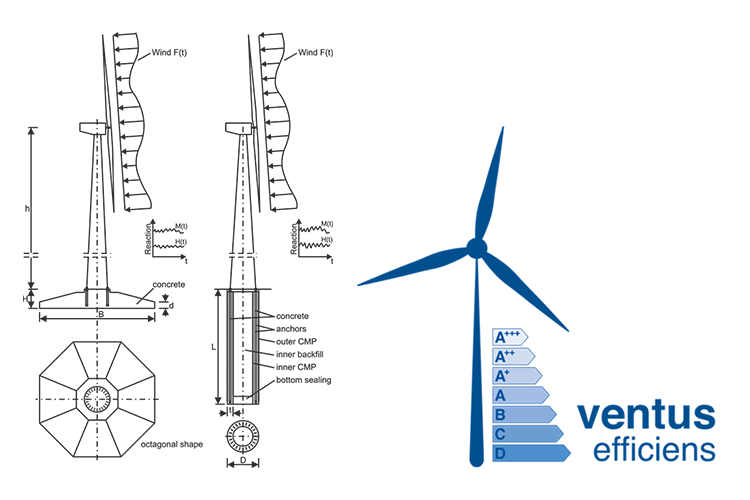ventus efficiens – Collaborative Research to Increase the Efficiency of Wind Turbines in the Energy System

| Led by: | Prof. Dr.-Ing. Martin Achmus |
| Team: | M.Sc. Mauricio Terceros, Dr.-Ing. Klaus Thieken |
| Year: | 2020 |
| Funding: | Niedersächsisches Ministerium für Wissenschaft und Kultur (MWK, Ministry for Science and Culture of Lower Saxony) |
| Duration: | 01.12.2014 – 30.06.2020 |
Description:
As an innovative foundation concept for onshore wind turbines, the pier foundation (P&H foundation) is being investigated by systematically analysing its technical feasibility. For this purpose, three-dimensional numerical simulations with the finite element method are required to achieve an actual modelling of the soil behaviour. A comparative study of the load-bearing behaviour between the pier and shallow foundations will be carried out.
The secant torsional stiffness is considered as a reference parameter in order to obtain an overview of the technical and economic feasibility, which also allows a comparison between the two foundation concepts. In addition, the load-bearing behaviour of the pier-soil system during unloading and reloading is investigated using a reference system with its traditional dimensions in order to be able to make correct predictions of the dynamic behaviour. This is decisive for the natural frequency of the entire structure of the onshore wind turbine.
On the other hand, the state of knowledge on the load-bearing behaviour of pile-founded structures in the field of offshore wind turbines is extended by the individual topics briefly explained below.
- For the analysis of the bearing behaviour of horizontally loaded foundation piles, the most commonly used p-y approaches for non-cohesive soils are implemented in the IGtHPile software in order to achieve a comparative study based on numerical simulations. A comprehensive parameter study with regard to the suitability of the already introduced p-y approaches was carried out using several layered soil profiles.
- The validity of the p-y methods recommended in the offshore guidelines was analysed by means of extensive numerical comparative studies. For this purpose, six static p-y methods for soft clay were implemented in the pile design programme IGtHPile. The investigated p-y methods all appear to be unsuitable for accurately representing the numerically determined load-bearing behaviour of piles with any dimensions and under any soil conditions.
- The foundation reactions were mapped in the form of load-dependent stiffness matrices, which enable a more accurate prediction in overall dynamic simulations due to the non-linear soil behaviour. This procedure for determining the foundation stiffness was embedded in the IGtHPile programme for all common p-y approaches.
- The cyclic deformation behaviour of horizontally loaded piles is investigated using the Stiffness Degradation Method (SDM) developed at the Institute of Geotechnical Engineering in order to predict the deformation accumulation. Three-dimensional numerical simulations are used to accomplish this task.
- Several pile length criteria are used for the design of monopile foundations, as the current offshore guidelines do not specify a clear procedure. For this reason, a comparative study of four frequently used criteria is carried out in order to determine the required embedment length of the monopile foundation in homogeneous sand.














